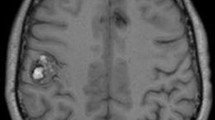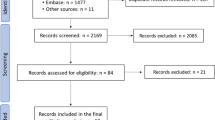Abstract
Headache may be caused by primary disorders, such as migraines, or secondary disorders, such as intracranial neoplasm or hemorrhage. Imaging plays an important role in differentiating between primary and secondary headache disorders. This article reviews the effectiveness of computed tomography (CT) and magnetic resonance imaging (MRI) in the evaluation of a patient with a headache. It also discusses the utility and cost-effectiveness of performing imaging studies in patients with a headache and a normal neurological exam. Emerging imaging techniques such as functional MRI, positron emission tomography (PET) scans, and voxel-based morphometry (VBM) are also discussed.
Similar content being viewed by others
References
Papers of particular interest, published recently, have been highlighted as: • Of importance •• Of major importance
Rasmussen BK et al. Epidemiology of headache in a general population—a prevalence study. J Clin Epidemiol. 1991;44(11):1147–57.
Robbins MS, Lipton RB. The epidemiology of primary headache disorders. Semin Neurol. 2010;30(2):107–19.
Lipton RB, Goadsby P, Silberstein SD. Classification and epidemiology of headache. Clin Cornerstone. 1999;1(6):1–10.
Gaughran CG, Tubridy N. Headaches, neurologists and the emergency department. Ir Med J. 2014;107(6):168–71.
Medina LS, M Debayle, and E Vasconcellos, Headache disorders: evidence-based neuroimaging, in evidence-based neuroimaging diagnosis and treatment, L.S. Medina, P. Sanelli, and J. Jarvik, Editors. 2013, Springer New York. p. 401–418. This particular paper is a comprehensive review for neuroimaging in headache disorders that provides a decision tree for adult and pediatric patients, for providers to use in their diagnostic workup.
Evans RW. Diagnostic testing for the evaluation of headaches. Neurol Clin. 1996;14(1):1–26.
Classification and diagnostic criteria for headache disorders, cranial neuralgias and facial pain. Headache Classification Committee of the International Headache Society. Cephalalgia, 1988. 8 Suppl 7: p. 1–96.
Clinch CR. Evaluation of acute headaches in adults. Am Fam Physician. 2001;63(4):685–92.
Turner DP, Houle TT. Psychological evaluation of a primary headache patient. Pain Manag. 2013;3(1):19–25.
Tsushima Y, Endo K. MR imaging in the evaluation of chronic or recurrent headache. Radiology. 2005;235(2):575–9.
Steiner TJ. Evaluation and management of headache in primary care. Expert Rev Neurother. 2004;4(3):425–37.
Sempere AP et al. Neuroimaging in the evaluation of patients with non-acute headache. Cephalalgia. 2005;25(1):30–5.
Martin VT. The diagnostic evaluation of secondary headache disorders. Headache. 2011;51(2):346–52.
Lewis DW, Koch T. Headache evaluation in children and adolescents: when to worry? When to scan? Pediatr Ann. 2010;39(7):399–406.
Lester MS, Liu BP. Imaging in the evaluation of headache. Med Clin North Am. 2013;97(2):243–65.
Donohoe CD. The role of the physical examination in the evaluation of headache. Med Clin North Am. 2013;97(2):197–216.
Donohoe CD. The role of laboratory testing in the evaluation of headache. Med Clin North Am. 2013;97(2):217–24.
Brenner M, Oakley C, Lewis D. The evaluation of children and adolescents with headache. Curr Pain Headache Rep. 2008;12(5):361–6.
Breen DP et al. Emergency department evaluation of sudden, severe headache. QJM. 2008;101(6):435–43.
Berdahl CT et al. Emergency department computed tomography utilization in the United States and Canada. Ann Emerg Med. 2013;62(5):486–494 e3. This article highlighted CAT scan utilization trends in the United States and Canada and shows how frequently we use cat scans in the United States compared to Canada. The article also discusses the financial costs and risk of adverse events from overuse of the study.
Frishberg BM. Neuroimaging in presumed primary headache disorders. Semin Neurol. 1997;17(4):373–82.
Rizk B et al. The role of unenhanced CT alone for the management of headache in an emergency department. A feasibility study. J Neuroradiol. 2013;40(5):335–41.
Mettler Jr FA et al. Medical radiation exposure in the U.S. in 2006, preliminary results. Health Phys. 2008;95(5):502–7.
Health Quality O. Neuroimaging for the evaluation of chronic headaches: an evidence-based analysis. Ont Health Technol Assess Ser. 2010;10(26):1–57.
Berrington De Gonzalez A et al. Projected cancer risks from computed tomographic scans performed in the United States in 2007. Arch Intern Med. 2009;169(22):2071–7.
DeVries A et al. CT scan utilization patterns in pediatric patients with recurrent headache. Pediatrics. 2013;132(1):e1–8.
Reports C. Many common medical tests and treatments are unnecessary: learn when to say ‘Whoa!’ to your doctor. Consumer Reports, 2012.
Akpek S et al. Cost-effectiveness of computed tomography in the evaluation of patients with headache. Headache. 1995;35(4):228–30.
Kahn Jr CE et al. Computed tomography for nontraumatic headache: current utilization and cost-effectiveness. Can Assoc Radiol J. 1993;44(3):189–93.
Larson EB, Omenn GS, Lewis H. Diagnostic evaluation of headache Impact of computerized tomography and cost-effectiveness. JAMA. 1980;243(4):359–62.
Holle D, Obermann M. The role of neuroimaging in the diagnosis of headache disorders. Ther Adv Neurol Disord. 2013;6(6):369–74. This article provides “red flags” and parts of the physical exam to focus on when identifying a role for obtaing neuroimaging.
Kranz P, Provenzale J. Imaging “worst headache of my life”: part 1. Applied Radiology. 2013;7(42):19–23.
Douglas AC et al. ACR appropriateness criteria headache. J Am Coll Radiol. 2014;11(7):657–67. This article specifically reviews primary and secondary disorders and provides the specific studies which should be ordered for each condition based on expert opinion from radiology.
Klink T, et al., Giant cell arteritis: diagnostic accuracy of MR imaging of superficial cranial arteries in initial diagnosis-results from a multicenter trial. Radiology, 2014: p. 140056.
Saindane AM et al. Association of MRI findings and visual outcome in idiopathic intracranial hypertension. American Journal of Roentgenology. 2013;201(2):412–8.
Bashir A et al. Migraine and structural changes in the brain: a systematic review and meta-analysis. Neurology. 2013;81(14):1260–8.
Dinia L et al. White matter lesions progression in migraine with aura: a clinical and MRI longitudinal study. Journal of Neuroimaging. 2013;23(1):47–52.
Hamedani AG et al. Migraine and white matter hyperintensities: the ARIC MRI study. Neurology. 2013;81(15):1308–13.
Seneviratne U, Chong W, Billimoria PH. Brain white matter hyperintensities in migraine: clinical and radiological correlates. Clin Neurol Neurosurg. 2013;115(7):1040–3.
Maniyar FH et al. Brain activations in the premonitory phase of nitroglycerin-triggered migraine attacks. Brain. 2014;137(1):232–41.
Kara B et al. DTI findings during spontaneous migraine attacks. Clin Neuroradiol. 2013;23(1):31–6.
Magon S., et al., Multi-center 3T MRI study of thalamic morphology in migraine using label-fusion-based segmentation and deformation based morphometric surface analysis. Neurology, 2014. 82 (10).
Olesen J. ICHD-3 beta is published use it immediately. Cephalalgia. 2013;33(9):627–8.
Robbins MS, et al. Headache, neurology in clinical practice. (2013);6164–73.
Bussone G. Strictly unilateral headaches: considerations of a clinician. Neurol Sci. 2014;35 Suppl 1:71–5.
May A. Pearls and pitfalls: neuroimaging in headache. Cephalalgia. 2013;33(8):554–65. This article is a very recent review that summarizes how important neuroimaging is in understanding headache pathophysiology and touches on new developments in advanced neuroimaging in primary headache disorders.
Naegel S, Holle D, Obermann M. Structural imaging in cluster headache. Curr Pain Headache Rep. 2014;18(5):415.
Compliance with Ethics Guidelines
Conflict of Interest
Dr. Deena E. Kuruvilla declares no potential conflicts of interest. Dr. Richard B. Lipton receives research support from the NIH: PO1 AG003949 (Program Director), PO1AG027734 (Project Leader), RO1AG025119 (Investigator), RO1AG022374-06A2 (Investigator), RO1AG034119 (Investigator), RO1AG12101 (Investigator), K23AG030857 (Mentor), K23NS05140901A1 (Mentor), and K23NS47256 (Mentor), the National Headache Foundation, and the Migraine Research Fund; serves on the editorial board of Neurology and Cephalalgia and as senior advisor to Headache, has reviewed for the NIA and NINDS, holds stock options in eNeura Therapeutics (a company without commercial products); serves as consultant, advisory board member, or has received honoraria from: Alder, Allergan, American Headache Society, Autonomic Technologies, Boston Scientific, Bristol Myers Squibb, Colucid, Dr. Reddy’s, Electrocore, Eli Lilly, Endo, eNeura Therapeutics, Informa, Labrys, Merck, Novartis, Teva, and Vedanta.
Human and Animal Rights and Informed Consent
This article does not contain any studies with human or animal subjects performed by any of the authors.
Author information
Authors and Affiliations
Corresponding author
Additional information
This article is part of the Topical Collection on Imaging
Rights and permissions
About this article
Cite this article
Kuruvilla, D.E., Lipton, R.B. Appropriate Use of Neuroimaging in Headache. Curr Pain Headache Rep 19, 17 (2015). https://doi.org/10.1007/s11916-015-0490-3
Published:
DOI: https://doi.org/10.1007/s11916-015-0490-3




